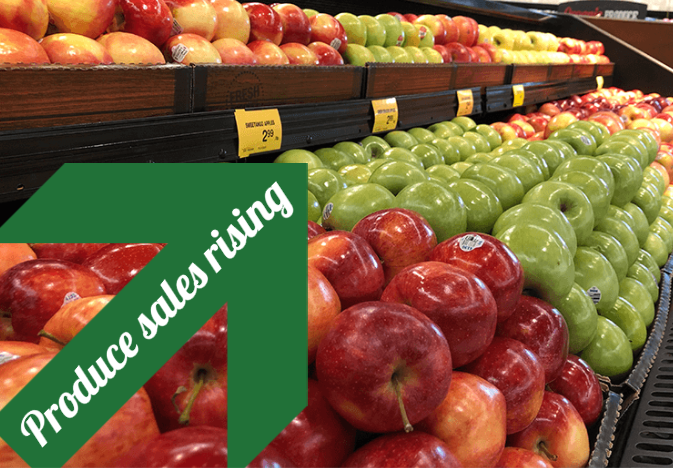RETAIL PRODUCE SALES RISING AMID CORONAVIRUS CONCERNS
03 Thu, 2020

Produce sales are rising as stock up trips continue. (Graphic by The Packer; made with Adobe Spark)
Stock-up grocery trips prompted by coronavirus concerns have included fresh produce along with frozen and canned, according to IRI and 210 Analytics.
Total-store sales, including perimeter, jumped 10.6% for the week ending March 8. Sales for the four-week period ending March 8 were up 4.5%, compared to 2.0% growth year-to-date, per IRI.
"Meat and deli meat sales are big drivers behind the perimeter growth, but produce sales too are accelerating fast — vegetables in particular," said Anne-Marie Roerink, principal of 210 Analytics. "For the week ending March 8, vegetable sales increased nearly 5%."
Vegetable sales for the week totaled $627.3 million, while fruit sales for the week – up 1.5% – accounted for another $570.1 million, according to IRI. Fresh produce overall was up 3.1% to $1.2 billion for the week.
"In addition to sales increases in fresh produce, frozen fruits and vegetables advanced 11.6% over the week ending March 8," Roerink said.
IRI reported total fresh perimeter sales were up 3.4% to $3.6 billion, while total store sales were $17.6 billion.
Nielsen statistics provide a look at some of the commodities that have recently been experiencing sales growth after previous declines.
Apples sales were up 19.8% for the week ending March 14 versus the same week the previous year. For the week ending March 7, sales had been down 3.2% year-over-year.
Banana sales were up 16.6% for the week ending March 14, contributing to a four-week total up 7.2% from the same period in 2019, per Nielsen.
Papaya sales were up 2.8% for the week ending March 14, compared to the same stretch in 2019. That growth reversed the trend of the week ending March 7, when sales were down 6.5% from 2019.
Celery sales had a similar experience, with growth of 2.7% for the week ending March 14. Sales for the week ending March 7 were down 18.7% year-over-year – not surprising as celery enjoyed an unprecedented surge in 2019 due to a juicing craze featuring the vegetable.
.jpg)
Source: https://www.thepacker.com/
Related Post
The true fishmeal carbon footprint
The established Life Cycle Analysis (LCA) methodology to assess the fishmeal carbon footprint only accounts for the vessel fuel and post-harvest processing energy while ignoring the carbon sequestration potential of fish.
View more
Freezing Tropical Fruits: Convenient and Effective Solution with Octofrost Machines
Tropical fruits are always a great choice for providing nutrition and fresh flavor to daily meals.
View more


